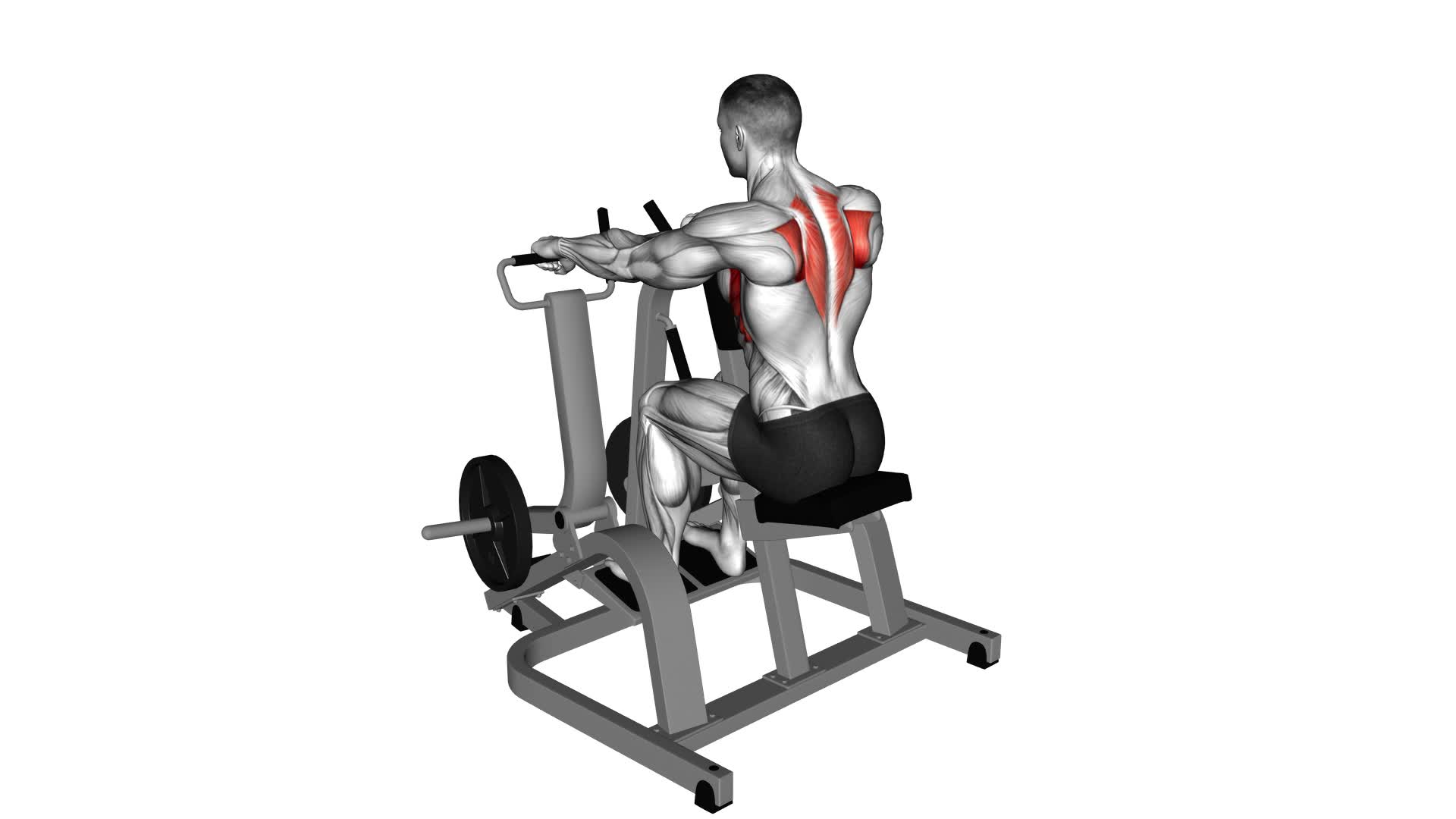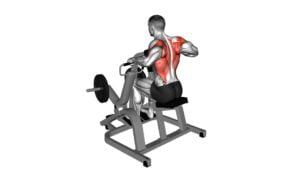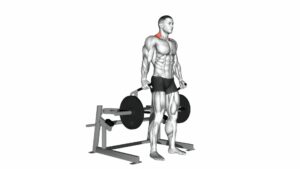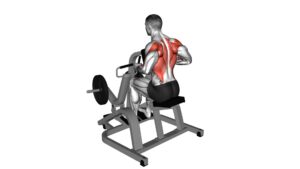Lever Pronated Grip Seated Scapular Retraction Shrug (Plate Loaded) – Video Exercise Guide & Tips

Are you looking to strengthen your scapular muscles and improve your posture?
Watch This Exercise Video
Look no further than the Lever Pronated Grip Seated Scapular Retraction Shrug. This plate loaded exercise targets your upper back and shoulders, helping you develop a strong and stable upper body.
In this video exercise guide, we'll walk you through the step-by-step process and provide helpful tips to ensure proper form and maximize the effectiveness of this exercise.
Get ready to take your upper body training to the next level!
Key Takeaways
- Improves posture by strengthening scapular retraction muscles
- Enhances shoulder stability
- Targets muscles in the upper back and shoulders
- Provides a well-rounded upper body workout
Benefits of the Lever Pronated Grip Seated Scapular Retraction Shrug
The Lever Pronated Grip Seated Scapular Retraction Shrug is an effective exercise that targets the muscles of the upper back and shoulders. By engaging in this exercise, you can experience a range of benefits.
Firstly, it helps to improve posture by strengthening the muscles responsible for scapular retraction. This can prevent rounding of the shoulders and promote a more upright position.
Additionally, the exercise helps to enhance shoulder stability, as it targets the muscles that support the shoulder joint. This can be particularly beneficial for individuals involved in activities that require overhead movements or heavy lifting.
Furthermore, the Lever Pronated Grip Seated Scapular Retraction Shrug allows for variations in grip positioning, enabling you to target different muscles within the upper back and shoulders. By incorporating these variations, you can ensure a well-rounded workout that targets all areas of the upper body.
Now that you understand the benefits of this exercise, let's explore the equipment needed for performing it.
Equipment Needed for the Exercise
To perform the Lever Pronated Grip Seated Scapular Retraction Shrug exercise, you'll need a plate-loaded machine. This exercise targets the muscles in your upper back and shoulders, helping to improve posture and strengthen the scapular retractors. To ensure proper form and maximize the benefits of this exercise, it's important to have the right equipment.
Here's what you'll need:
- Plate-loaded machine: This exercise requires a plate-loaded machine that allows you to adjust the weight according to your fitness level.
- Seat with back support: Look for a machine that has a seat with back support to maintain proper posture throughout the exercise.
- Handlebars or grips: The machine should have handlebars or grips that allow you to hold onto and retract your scapulae effectively.
- Weight plates: Make sure you have weight plates available to load onto the machine.
- Safety pins: Some plate-loaded machines may come with safety pins to secure the weights in place, ensuring your safety during the exercise.
Now that you know the equipment needed, let's move on to the step-by-step guide on how to perform the lever pronated grip seated scapular retraction shrug.
Step-By-Step Guide on How to Perform the Lever Pronated Grip Seated Scapular Retraction Shrug
To perform the Lever Pronated Grip Seated Scapular Retraction Shrug, you'll need to adjust the weight on the plate-loaded machine and position yourself on the seat with back support. Here is a step-by-step guide to help you perform the exercise correctly:
- Start by sitting on the machine with your feet flat on the floor and your back against the backrest.
- Adjust the weight on the machine to a comfortable level for your fitness level and goals.
- Grasp the handles with a pronated grip, palms facing down.
- Keep your elbows slightly bent and your shoulders relaxed.
- Inhale and retract your shoulder blades, pulling them back and down.
- Exhale and slowly raise your shoulders up towards your ears, squeezing your shoulder blades together.
- Hold the contraction for a second and then slowly lower your shoulders back to the starting position.
- Repeat for the desired number of repetitions.
Here are a few tips for performing the Lever Pronated Grip Seated Scapular Retraction Shrug:
- Focus on maintaining proper form throughout the movement.
- Avoid shrugging your shoulders up towards your ears.
- Keep your neck relaxed and avoid straining it.
- Engage your core muscles to stabilize your body during the exercise.
Common Mistakes to Avoid During the Exercise
To ensure proper form and maximize the effectiveness of the Lever Pronated Grip Seated Scapular Retraction Shrug, there are a few common mistakes you should avoid.
- Firstly, make sure your hand placement is correct by gripping the handles with a pronated grip.
- Secondly, don't forget to retract your shoulders back and down throughout the entire movement to engage the scapular muscles.
- Lastly, be mindful of your shrug technique, ensuring that you're lifting the weight using your traps and not relying on momentum or excessive arm involvement.
Incorrect Hand Placement
Ensure proper hand placement to avoid common mistakes during the Lever Pronated Grip Seated Scapular Retraction Shrug exercise.
Incorrect hand positioning can lead to ineffective execution and potential injury. To maximize the benefits of this exercise, remember the following:
- Grip strength: Maintain a firm grip on the handles throughout the movement. This will help stabilize your upper body and engage the targeted muscles effectively.
- Hand positioning: Place your hands evenly on the handles, making sure they're shoulder-width apart. This will provide optimal leverage and balance during the exercise.
- Avoid excessive pressure: Don't squeeze the handles too tightly, as it may cause unnecessary strain on your wrists and forearms.
- Maintain a neutral wrist position: Keep your wrists aligned with your forearms throughout the movement. Avoid bending or flexing them to prevent discomfort or injury.
- Recheck hand placement: Before starting the exercise, double-check that your hands are securely positioned on the handles to ensure stability and control.
Lack of Shoulder Retraction
Avoid slouching or rounding your shoulders forward during the Lever Pronated Grip Seated Scapular Retraction Shrug exercise to ensure proper shoulder retraction. Maintaining proper shoulder alignment is crucial for maximizing the benefits of this exercise and preventing injury.
Lack of shoulder retraction can limit your range of motion and compromise the effectiveness of the exercise. To improve shoulder mobility and strengthen the targeted muscles, focus on retracting your shoulder blades by pulling them back and down. This will help activate the muscles in your upper back and promote proper posture.
By engaging in shoulder retraction, you'll enhance the effectiveness of the exercise and prevent any unnecessary strain on your neck and shoulders.
Now let's move on to discussing the improper shrug technique and how to avoid it.
Improper Shrug Technique
- Start by gripping the lever with a pronated grip and sitting in a seated position with proper posture.
Improper form during the shrug exercise can lead to discomfort and potential injury. To ensure you're performing the exercise correctly and preventing any harm, be mindful of the following common mistakes:
- Avoid rounding your shoulders forward, as this can strain the neck and upper back muscles.
- Don't hunch or excessively arch your back, as it can put unnecessary stress on the spine.
- Don't use excessive momentum or jerk the weight, as this can lead to muscle strains or tears.
- Avoid shrugging your shoulders up towards your ears, as this can place excessive tension on the neck muscles.
- Don't forget to engage your scapular muscles throughout the entire movement to reap the full benefits of the exercise.
Tips for Maximizing the Effectiveness of the Exercise
To enhance the effectiveness of the lever pronated grip seated scapular retraction shrug (plate loaded) exercise, focus on maintaining proper form throughout the movement. By doing so, you can maximize results and ensure optimal muscle activation.
First and foremost, pay attention to your posture. Sit with your back straight and shoulders relaxed. Avoid slouching or rounding your back, as this can hinder the effectiveness of the exercise.
When gripping the handles, make sure your palms are facing down (pronated grip). This hand position targets the muscles in the upper back and shoulders more effectively.
As you perform the shrug, focus on retracting your shoulder blades. Imagine squeezing them together as you lift the weight. This action engages the muscles in your upper back, specifically the rhomboids and trapezius.
Make sure to lift the weight in a controlled manner. Avoid using momentum or jerking movements, as this can diminish the effectiveness of the exercise. Lift the weight smoothly and lower it under control.
Lastly, breathe properly throughout the exercise. Inhale as you lower the weight and exhale as you lift it.
Variations and Modifications for All Fitness Levels
Maintain proper form and maximize the effectiveness of the lever pronated grip seated scapular retraction shrug (plate loaded) exercise by considering variations and modifications for all fitness levels. Here are some variations and progressions to help you tailor the exercise to your specific needs:
- Resistance Level: Adjust the weight load on the plate-loaded lever machine to match your current strength level. Start with a lighter weight and gradually increase as you become more comfortable and stronger.
- Hand Position: Experiment with different hand positions on the machine's handles to target different muscle groups. You can try a pronated grip (palms facing down) or a supinated grip (palms facing up) to engage the muscles in slightly different ways.
- Range of Motion: Control the movement and focus on squeezing your shoulder blades together at the top of the exercise. You can also experiment with different ranges of motion, such as holding the contraction for a few seconds or adding a pause at the top before returning to the starting position.
- Unilateral Variation: To challenge your core stability and balance, try performing the exercise one arm at a time. This will also help to identify and correct any muscle imbalances.
- Progressive Overload: As you become more proficient in the exercise, you can gradually increase the intensity by using heavier weights, performing more repetitions, or adding additional sets.
Frequently Asked Questions
How Many Sets and Reps Should I Do for the Lever Pronated Grip Seated Scapular Retraction Shrug?
To determine the number of sets and reps for the lever pronated grip seated scapular retraction shrug, you need to consider shoulder stability and your fitness goals. It's recommended to start with 2-3 sets of 10-12 reps, focusing on proper form and controlled movements.
This exercise targets the muscles involved in scapular retraction and can be an effective way to improve shoulder stability.
Can I Perform This Exercise if I Have a Shoulder Injury?
If you have a shoulder injury, it's essential to be cautious with exercises that might aggravate it. The Lever Pronated Grip Seated Scapular Retraction Shrug may not be suitable for you in this case.
It's crucial to prioritize your shoulder's recovery and consult with a medical professional for suitable modifications or alternative exercises that could help you strengthen your scapular muscles without exacerbating your injury.
Is It Necessary to Use a Plate-Loaded Machine for This Exercise, or Can I Use Dumbbells Instead?
Yes, you can use dumbbells as an alternative to a plate-loaded machine for the Lever Pronated Grip Seated Scapular Retraction Shrug exercise. Using dumbbells allows for a similar movement pattern and targets the same muscles.
Just make sure to choose an appropriate weight and maintain proper form throughout the exercise. It's important to focus on retracting your shoulder blades and shrugging your shoulders in a controlled manner to get the most benefit from this exercise.
How Long Should I Hold the Retracted Position During Each Rep?
During each rep, you should aim to hold the retracted position for about 2-3 seconds. This allows for maximal activation and strengthening of the muscles involved in scapular retraction. Holding the position also helps improve posture, shoulder stability, and overall upper body strength.
Scapular retraction is an important aspect of many exercises as it helps engage the muscles of the upper back and promotes proper alignment.
Can I Incorporate This Exercise Into My Upper Body or Back Workout Routine?
Yes, you can definitely incorporate this exercise into your upper body or back workout routine.
The Lever Pronated Grip Seated Scapular Retraction Shrug has many benefits, including improved posture, increased strength in your upper back and shoulders, and enhanced scapular stability.
Conclusion
In conclusion, the lever pronated grip seated scapular retraction shrug is a highly effective exercise for strengthening and activating the muscles in the scapular region.
By using proper form and avoiding common mistakes, individuals can maximize the effectiveness of this exercise.
Additionally, variations and modifications are available for all fitness levels, making it accessible to a wide range of individuals.
Incorporating this exercise into a regular workout routine can contribute to improved shoulder stability and overall upper body strength.

Author
Years ago, the spark of my life’s passion ignited in my mind the moment I stepped into the local gym for the first time. The inaugural bead of perspiration, the initial endeavor, the very first surge of endorphins, and a sense of pride that washed over me post-workout marked the beginning of my deep-seated interest in strength sports, fitness, and sports nutrition. This very curiosity blossomed rapidly into a profound fascination, propelling me to earn a Master’s degree in Physical Education from the Academy of Physical Education in Krakow, followed by a Sports Manager diploma from the Jagiellonian University. My journey of growth led me to gain more specialized qualifications, such as being a certified personal trainer with a focus on sports dietetics, a lifeguard, and an instructor for wellness and corrective gymnastics. Theoretical knowledge paired seamlessly with practical experience, reinforcing my belief that the transformation of individuals under my guidance was also a reflection of my personal growth. This belief holds true even today. Each day, I strive to push the boundaries and explore new realms. These realms gently elevate me to greater heights. The unique combination of passion for my field and the continuous quest for growth fuels my drive to break new ground.







